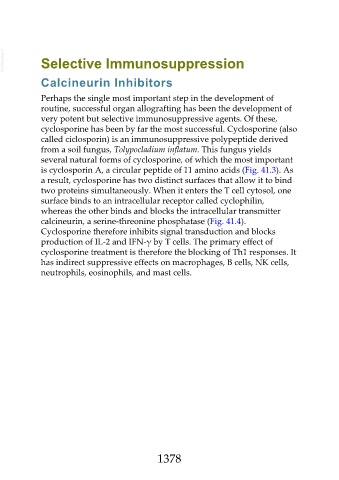Page 1378 - Veterinary Immunology, 10th Edition
P. 1378
VetBooks.ir Selective Immunosuppression
Calcineurin Inhibitors
Perhaps the single most important step in the development of
routine, successful organ allografting has been the development of
very potent but selective immunosuppressive agents. Of these,
cyclosporine has been by far the most successful. Cyclosporine (also
called ciclosporin) is an immunosuppressive polypeptide derived
from a soil fungus, Tolypocladium inflatum. This fungus yields
several natural forms of cyclosporine, of which the most important
is cyclosporin A, a circular peptide of 11 amino acids (Fig. 41.3). As
a result, cyclosporine has two distinct surfaces that allow it to bind
two proteins simultaneously. When it enters the T cell cytosol, one
surface binds to an intracellular receptor called cyclophilin,
whereas the other binds and blocks the intracellular transmitter
calcineurin, a serine-threonine phosphatase (Fig. 41.4).
Cyclosporine therefore inhibits signal transduction and blocks
production of IL-2 and IFN-γ by T cells. The primary effect of
cyclosporine treatment is therefore the blocking of Th1 responses. It
has indirect suppressive effects on macrophages, B cells, NK cells,
neutrophils, eosinophils, and mast cells.
1378

